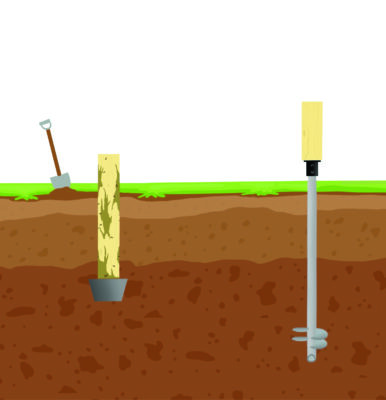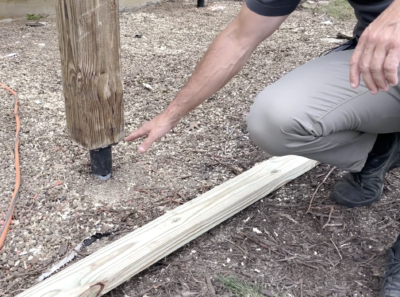Understanding Helical Piles Vs. Traditional Foundation Methods
When it comes to deck building, helical piles are a carpenter’s dream. Deck piles provide a more reliable and efficient solution compared to other foundations. Essentially, helical piles are large metal screws driven deep into the earth to hold up your frame, while other traditional foundations involve digging posts a few feet into the ground. With helical piles, the deck building process will be quicker, have less environmental disruption, and provide superior structural integrity. In this blog, we put helical pile technology and traditional practices head to head, to find out which is superior to the other.
Traditional Methods
Most often when someone hears, “Traditional foundation methods” they are not sure what that entails. In the deck-building industry, there are 2 common ways to lay your foundation. One method includes a pre-casted concrete footer that is placed in a large hole 14in wide and 39-42in deep. After the footer is placed in the hole, a 4×4 wood post is dropped on top. Following the placed post, you will refill the hole with dirt and you are done. The second option requires the same process, minus the footer and adding liquid concrete, otherwise known as Quikcrete. Once the wood post is placed in the hole, you surround the post with Quikcrete. After the concrete sets, you will be done with your foundation. Both of these methods have established themselves, but have their flaws as years come and go.
Greater Load Capacity
One of the key advantages of using helical piles for deck foundations is their greater load capacity. As a deck builder, you know that a solid foundation is critical to ensure that your deck can withstand the weight of furniture, people, and hot tubs. Safety for you and your family is always a priority, and often what you see with traditional posts is shifting, lifting, or sinking over time, leading to significant problems. With poured concrete, there are a few variables that could go wrong. Even though the post is surrounded by heavy and durable concrete, it’s not that easy. Concrete can be set wrong if it rains while it dries, or if you mix it incorrectly. Now you have a possible cause for concern around its structural integrity. Additionally, with the footer foundation, you are relying on one footer at the base and a bunch of loose dirt to keep your foundation stable. Shifting, lifting, and sinking will cause your deck to be unlevel and shift your entire deck. With helical piles, however, you can be confident that your deck foundation will remain stable and secure for decades. These piles are 4-6ft in the ground compared to 3ft with a typical 4×4 post. Not only are piles deeper but have been engineered to hold greater weight for much longer. Overall, if you’re looking for a deck foundation that can provide greater load capacity and long-term stability, then helical piles are an excellent choice. With their innovative design and engineering, these piles offer a superior alternative to traditional post-setting methods and can help ensure that your deck is secure, safe, and reliable for years to come.
Environmentally Friendly
In addition to the speed and strength advantages of helical piles for deck foundations, there’s also a compelling case to be made for their eco-friendliness. Unlike the traditional way of setting posts in the ground, helical piles create minimal damage to your yard during installation.
The old way requires digging deep, wide holes (14in diameter) in the ground that are difficult to fill back in. Helical piles are screwed into the ground using a drill, the soil disturbance is much lower, leaving your yard looking much cleaner. Furthermore, because helical piles are designed to last for decades, they help reduce the need for additional deck repairs and replacements down the line. The reduced use of wood also helps to preserve the environment, as it cuts down the number of trees harvested. Overall, compared to the traditional way of setting posts in the ground helical piles take the win on this one. It’s no wonder that more and more homeowners are turning to this innovative technology to get their decks up and running.
longevity and Protection
Probably the biggest advantage of helical piles is their longevity and frame protection. Traditional deck posts are often in direct contact with the earth, making them susceptible to rapid rotting. Over time, exposure to moisture, insects, and other environmental factors can cause wooden posts to decay, weaken, and eventually fail. This can lead to safety hazards, costly repairs, and even the need to replace the entire deck. In contrast, helical piles are made from durable materials such as galvanized steel and are built to withstand the elements. Helical piles are designed to peak above the surface of the earth, keeping all of your wood framing out of the moist ground. This eliminates all of the negative effects of direct earth contact used in most traditional methods. By using piles for your deck foundation, you can have more peace of mind knowing that your deck will remain strong, stable, and safe for years and years. We all want something that lasts a long time, but more importantly, something that our family can make memories on for generations.
Faster to Install
Contrary to the traditional way of setting posts in the ground, helical piles are much faster to install. Helical piles are driven down into the ground using a diesel-powered machine, resulting in accurate leveling and speedy timing. The machine used to screw the pile creates precise PSI measurements to get accurate depth and stability. This process is much quicker than hand-digging holes, and filling them with concrete footers. If you do poured concrete it will be even slower. You have to wait for the concret to fully set and dry to start building on the posts. It’s simply more efficient and cost-effective to have a deck builder use this method. Not to mention, it can make the building process go much smoother with less stress for the homeowner. Helical piles are a game-changer, and once you try them, you’ll never go back to the traditional method again.
Read more: The Importance and Benefits of Professional Deck Installation
Conclusion
Helical Piles provide a stronger, more efficient, and environmentally friendly foundation compared to traditional methods, offering greater load capacity, durability, and faster installation.At WoodlandDeck, we offer expert deck services in Columbus, Delaware, Westerville, Sunbury, and surrounding areas. Along with Helical Piles, we specialize in custom deck design & building, custom deck remodeling, deck resurfacing, and deck lighting services to create the perfect outdoor space. Contact us today to get started on your dream deck!






